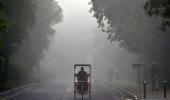Pollution levels skyrocketed by the hour in Delhi on Sunday, turning the air quality hazardous, which agencies consider unfit for inhalation even by healthier people.

The hourly graph of the Central Control Room for Air Quality Management, which had briefly fallen below emergency levels on Saturday, recorded PM2.5 and PM10 concentration at 478 and 713 microgram per cubic metre by afternoon.
The corresponding 24-hour safe standards are 60 and 100. Visibility came down below 100 metres at many places.

The air quality index of the CPCB had a score of 460, as against Saturday’s 403. The most dominant pollutants were PM2.5 and CO, according to the CPCB air bulletin.
People complained of burning sensation in their eyes and heaviness in breathing, reflecting the severity of the pollution.
The PM2.5 reading of the Centre-run System of Air Quality and Weather Forecasting And Research was also above 400, which is in the severe category as well.
If the prevailing levels of PM2.5 and PM10 persist for another 24 hours, the odd-even scheme is supposed to be implemented, according to the Graded Response Action Plan being enforced by the Environment Pollution (Prevention and Control) Authority.

The National Green Tribunal had on Saturday said that the odd-even scheme should be implemented “without any default” as and when PM (particulate matter) 10 level goes above 500 microgram per cubic metre and PM 2.5 level crosses the limit of 300 microgram per cubic metre during a span of 48 hours.
CPCB and SAFAR scientists maintained that the fresh spike in pollution was triggered mainly due to drop in inversion layer (the layer beyond which pollutants cannot disperse into the upper layer of the atmosphere), which in turn happened due to sharp drop in minimum and maximum temperatures.
The CPCB’s air lab chief Dipankar Saha said the haze was basically a mixture of dust and moisture. Formation of a thick cloud cover also resulted in the spike in moisture and drop in both minimum and maximum temperatures, he said.











 © 2025
© 2025